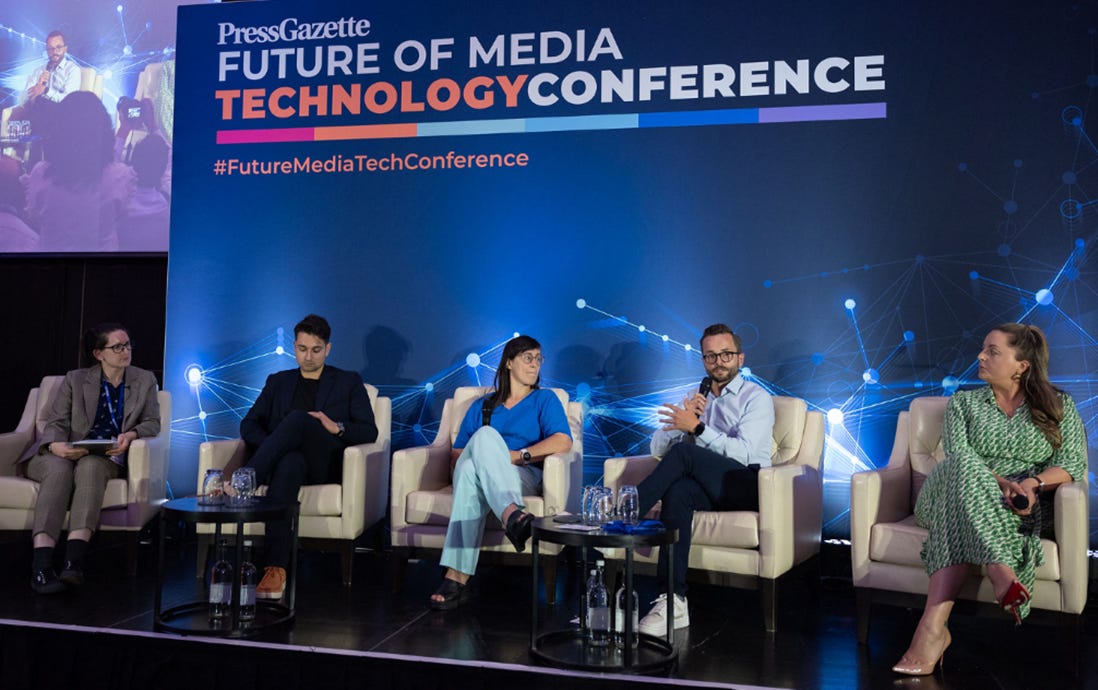
This is an excerpt from my Substack newsletter, The News Angle, published on October 6th 2023. Image: Midjourney.
A significant focus for this Substack newsletter over the coming year will undoubtedly be generative AI, and its impact on TV News and journalism. I’ve become a bit of a nerd on the subject, and am fascinated by AI’s potential and pitfalls.
I spent 25 years as a production TV news journalist, closely involved in the mechanics of producing TV News programmes – compiling running orders, writing newscaster lead-ins, reviewing reporter scripts, ordering archive pictures, commissioning graphics, working with video editors on packages and video sequences (in house and on the road), and attending news desk planning meetings.
I worked with highly skilled colleagues – specialist lead-in writers and chief subs, reporters, programme editors, video editors, graphic designers, library archivists, and studio control room staff.
And… to be honest, I just can’t see how generative AI won’t impact each and every one of those activities and disciplines. To put it another way, I can’t think of an area of TV news production that won’t be affected by AI.
Yes, human involvement will still be crucial. Indeed, eliminating the more repetitive tasks will no doubt free up time for more creative work and more proactive journalism.
Yes, AI will no doubt lead to new jobs and roles, as some current repetitive activities are replaced by automated systems.
Yes, viewers will expect to see a real human presenting a live TV news programme (although I’m not sure they’ll mind AI presenters delivering social media summaries).
And, yes, there will be a greater premium on eye-witness reporting and camera work out on the road.
But there are still lots of aspects of TV news production that will be impacted by AI.
And, of course, beyond its impact on production roles and newsroom activities, generative AI will also lead to all sorts of misinformation and false videos and images – which in turn, will require newsrooms to develop a range of sophisticated defensive verification systems.
So, one way or another, AI will, in my view, have a transformational impact on TV news. Not straight away, but certainly within a few years.
I’ll delve more into this in the coming months.

ITN’s Jon Roberts and AI
I gained a valuable insight into the AI and journalism debate at the Press Gazette’s Future of Media Technology Conference, held in London on Wednesday 6th September.
Jon Roberts, ITN’s Director of Technology, Production and Innovation, spoke at the event about how Artificial Intelligence was affecting the ITN1 newsroom. I wrote up the key points of his presentation for the ITN 1955 Club magazine2.
Here is an excerpt from my article:
Jon Roberts, ITN’s Director of Technology, Production and Innovation spoke at a Press Gazette media technology event in September about Artificial Intelligence.
He said: “We want to embrace AI wherever we possibly can… but we need to do it responsibly and safely.”
He described generative AI as “very exciting”, and that they were in “the co-pilot phase of AI”, with the aim of enhancing productivity and giving journalists better tools for finding and telling stories.
When asked about whether teams are nervous about AI’s impact on staff, he replied: “The jobs question comes up very quickly, and we are mindful of this.” He said: “Our job is to be open about AI. We are having a conversation across the company about it.” He said ITN had issued AI guidelines earlier in the year, and since then had set up cross-company working groups to look at the impact of AI.
He argued that AI is particularly good at tagging and searching media content, is already offering new graphics and editing tools, and has huge potential for re-versioning content, including automated transcriptions, translations and summaries.
But he added that “change is difficult to drive in a newsroom”, and many production systems have “become ingrained”. He describes how there was “natural caution” in the newsroom. He said they had discussed how AI may take some of the drudgery away – but then went on to say that some in the newsroom have argued that learning how to do those basic tasks is what makes you a good journalist.
Jon said that in the last year, AI has taken up “an awful lot of my time… It’s a challenge, because it’s moving so quickly. New AI tools are coming out by the week.”
He explained that ITN, as a company, had always been affected, every 10 years or so, by new technology, whether it was ENG, SNG, or computer graphics. And now, he said, it’s AI.
An interesting presentation. With my old journalism hat on, if I had to pull out a headline it would be: ITN to embrace AI “wherever we possibly can”.
But a more considered take-away from his presentation is that ITN is clearly taking generative AI seriously, and seeing how it could improve production systems across the company, particularly in providing ‘co-pilot’ functions – but, at the same time, the company is approaching AI cautiously, and there are concerns from staff about how it will affect jobs and roles.
ITN is initially going for the low-hanging fruit – improving tagging and searching for archive video, and automating the reversioning of content in different languages for international clients. But the sense I got from Jon’s presentation, is that ITN is open-minded about more ambitious and radical steps…
